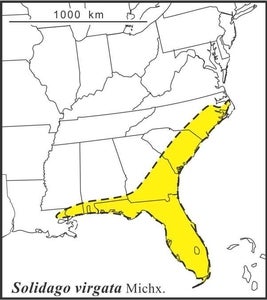Wand or Wand-like Goldenrod

Solidago virgata Michx. (S. stricta sensu authors not Ait.) is distinguished by its always narrow (wand like) inflorescence, which can be 50 cm long or more but only 3-5 cm wide. The ascending lower branches are never elongated except when the inflorescence is damaged. The basal leaves are entire and slightly crenate, but not serrate; leaf shape is variable with blades broadly to narrowly oblanceolate. The stem leaves are quickly reduced and numerous on tall stems. Small plants of S. austrina, S. gracillima and S. stricta (revised application of name) with small inflorescences can be confused with S. virgata, but robust plants of these first three species have inflorescences with spreading to arching elongated to very elongated lower branches; the first two also have serrate rosette and lower stem leaves (Semple 2012; note that name S. stricta is misapplied in that publication). When tall stems bend over before inflorescence maturation, then the inflorescence branches tend to orient upward and elongate, yielding an atypical secund branching pattern.
Solidago virgata Michx. is the correct name for the species long known as S. stricta sensu authors not Aiton (1789). Semple (2013) noted that S. stricta was misapplied by Torrey & Gray in the 1842 Flora of North America to S. uliginosa; they correctly used the name S. virgata, but applied it more broadly than here. Later A. Gray (1882) noted the reasons for misapplying the name S. stricta and broadly defined it to included plants Fernald placed much later in S. perlonga, a name Semple (2012) recommended using for a distinct species found mostly in New Jersey and Virginia. Semple (2013) noted that S. stricta Ait. is the correct name for S. perlonga Fernald, which now belongs in synonymy under the Aiton name.
Solidago virgata includes three ploidy levels: diploid (2n=18) from North Carolina to South Florida, tetraploid (2n=36) in a few locations, and hexaploid (2n=54) from North Carolina to northern Florida and southern Alabama resulting in variation in involucre height and floret length. Semple and Cook (2022) summarized and mapped the cytogeography of all species in Solidago sect. Maritimae including S. virgata.
The species is native to the outer coastal plain from North Carolina to Louisiana. Based on the multivariate study of the S. stricta complex (Semple et al. 2016), the range of S. virgata has been reduced to reaching just into eastern Louisiana. Outer coastal plain plants in much of Louisiana and along the Texas Gulf coast are included here in S. mexicana; inflorescences tend to be slightly secund apically, unlike in S. virgata. In subtropical Florida, very linear-leaved short plants belong in S. chrysopsis. Tall more northern plants of S. virgata can have narrow basal leaves, but these are much longer usually than those of S. chrysopsis. Small plants of S. virgata in coastal North Carolina might be confused with tall plants of S. pulchra.
Semple, J.C. 2012. Typification of Solidago gracillima (Asteraceae: Astereae) and application of the name. Phytoneuron 2012-107: 1-10.
Semple, J.C. 2013. Application of the names Solidago stricta and S. virgata (Asteraceae: Astereae). Phytoneuron 2013-42. 1-3.
Semple, J.C., T. Shea, M. El-Swesi, H. Rahman, and Y. Ma. 2016. A multivariate study of the Solidago stricta complex (Asteraceae: Astereae: S. subsect. Maritimae). Phytoneuron 2016-86. 1-34.
Semple, J.C. and R.E. Cook. 2022. Cytogeography of Solidago sect. Maritimae (Asteraceae: Astereae). Ann. Mo. Bot. Garden 107: 21-31.
Last revised 11 April 2025 by J.C. Semple
© 2025 J.C. Semple, including all photographs unless otherwise indicated

1-6. Solidago virgata. 1. Tall plants in road margin ditch, Semple 10919, Jefferson Co., Florida. 2. Very tall shoots, Semple & Godfrey 3120, Bay Co., Florida. 3. Basal leaves, Semple 11777, Orangeburg Co., South Carolina. 4. Long inflorescence, S 10919. 5. Fruiting inflorescence, Semple 11685, Liberty Co., Florida. 6. Heads, Semple & Suripto 9763, Brunswick Co., North Carolina.











